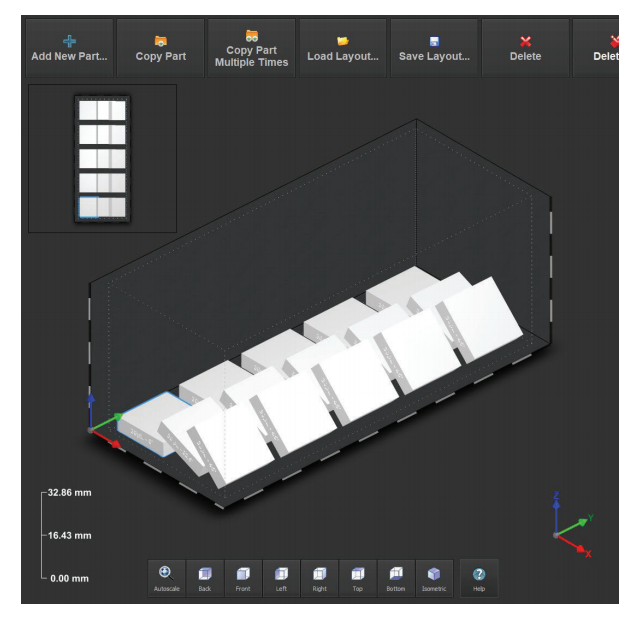Binder Jet 3D Printing: Studying Print Speed & Effects on Surface Roughness & Density
International researchers study different features that affect binder jetting, outlining their findings in the recently published ‘The Effect of Print Speed on Surface Roughness and Density Uniformity of Parts Produced Using Binder Jet 3D Printing.’ Binder jetting continues to be popular with industrial users because it is fast; however, that does not mean prints come out perfect, leaving the scientists here to work on methods for improving the overall outcomes of prototypes and parts.
Fabrication of a binder jetting part relies on:
- Powder dispensing
- Powder spreading
- Binder dispensing
- Binder drying
“The printing time (the time it takes to dispense binder droplets) can be decreased by either increasing the number of printing modules in the machine itself, or by increasing the speed at which the printhead traverses across the bed. However, increasing the printhead traverse speed can negatively affect the feature resolution and dimensional accuracy.”
Consistency is one of the most critical elements to production, and especially in manufacturing parts with close tolerances, however, the following issues can cause interruption to a good flow rate and consistency:
- Machine wear
- Machine cleanliness
- The number of times powder is recycled
- Humidity in the air
For this study, the researchers investigated how powder speed will affect density of green body parts, long with surface roughness during sintering. They also explored how layer thickness and droplet size affect surface roughness. The research team 3D printed on an ExOne Innovent+ binder jet printer using the ExOne solvent binder at 70% saturation.
Five different coupon samples were sintered, measured, and weighed. Surface roughness was then measured five times.

a) Schematic of a coupon being tested 5 times in various positions across the surface of the coupon and b) schematic of the stylus traverse direction against layer thickness of angled coupons.
There were six printing trials in all, with each one of them demonstrating that increase of powder spread result in a density increase. Slow spreading speeds allowed for the greatest consistency in powder packing density.
“Although the coupons with the 50 μm layer thickness have a lower average green density than the 30 μm layer thickness, the coupons were able to sinter to over 98% dense,” stated the researchers. “When evaluating the effect coupon angle has on green density, the average density decreases with increased coupon angle.
“The surface roughness (Ra) typically increases with faster spreading speeds and increased coupon orientation angle,” concluded the researchers. “The smallest average surface roughness value (Ra) was found to be 4.05 μm with the 50 μm layer thickness and 30 pLa printhead on a flat surface with a spread speed of 3 mm/sec. The largest average roughness (Ra) was found to be 9.78 μm with the 50 μm layer thickness and 30 pL printhead on a 22.5° coupon with a 125 mm/sec spread speed.”
As researchers worldwide continue to study binder jet 3D printing, from use with materials like aluminum alloys to experimental powders, ceramic 3D printing, and more. What do you think of this news? Let us know your thoughts! Join the discussion of this and other 3D printing topics at 3DPrintBoard.com.
[Source / Images: ‘The Effect of Print Speed on Surface Roughness and Density Uniformity of Parts Produced Using Binder Jet 3D Printing’]Subscribe to Our Email Newsletter
Stay up-to-date on all the latest news from the 3D printing industry and receive information and offers from third party vendors.
Print Services
You May Also Like
3D Printing Financials: Prodways Ends 2024 with a Profit
After a tough couple of years, Prodways (EPA: PWG) is starting to bounce back. The French 3D printing company finally made a profit in 2024, improved its operating performance, and...
Blue Origin & Auburn University Use EOS M290 to Study Copper 3D Printing
Blue Origin, the commercial space company built off of investments from Amazon founder Jeff Bezos, has donated two EOS M290 powder bed fusion (PBF) printers to Auburn University’s National Center...
Rocket Lab to Acquire Restructured Laser Communications Provider Mynaric AG
Rocket Lab USA, the Long Beach-based, end-to-end space services company that specializes in producing rockets with additive manufacturing (AM), has announced plans to acquire Mynaric AG, a German provider laser...
3D Printing Financials: Stratasys Ends 2024 with Cost Cuts and Growth Plans
Stratasys (Nasdaq: SSYS) has wrapped up 2024 with stronger margins but a full-year net loss. The polymer 3D printing leader navigated a year of economic headwinds, restructuring efforts, and shifting...






























